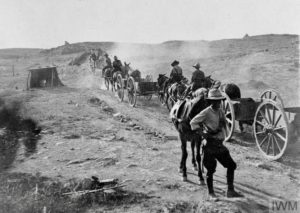Tuesday June 25th, 1918
Reveille 4:30, breakfast 5. No parade. Visit E. F. Canteen. Nothing doing. Very hot again. CO Parade 5:15pm. Sand storm. CO’s parade a washout.
Sandstorm
The heat of the summer has turned the plains of Salonika into dust. This combined with high winds seems to be causing problems for the 13th. Frank could have called the COs parade a ‘dry-out’ rather than a ‘wash-out’. The men are clearly struggling with the weather and the Battalion Diary today records that Wednesday afternoons are to be half holidays – war permitting.
Marching in a Column
Frank wasn’t the only person to be troubled by the dust. Illtyd Davies, of B Battery, 100 Brigade RFA, 22nd Division, had been even more discombobulated two years earlier on a march to Sarigueul:

‘In early June [1916] we marched out of the hills on our way to meet the Bulgar, the whole brigade in column of route, about a mile long procession, causing a huge cloud of white dust to rise over one hundred feet into the air, thereby advertising to the enemy that we were on our way to meet him. What strategy – and what a target for enemy planes, but none showed up, no doubt the enemy expected all of us to choke to death in the dust.’
Men and horses were caked with a mixture of dust and sweat. The dust was so thick one could not see from the wheelers to the leaders, drinking water was also very scarce. The colonel and his staff rode at the head of the column fairly free of dust, but D Battery and the Ammunition column, trailing along at the rear of the mile long cavalcade, must have nearly choked to death.’¹
The photograph shows British mule-drawn limbers near Daudli, north of Salonika in July 1916.* The column is short and the photograph taken of those at the front – despite this, dust clouds are visible.
Apparently the Commanding Officers of the various units complained of the formation. When they moved on a week later to Kukus, each battery travelled separately.
Driving on a Summer’s Day
The 100th Brigade comprised mostly horses and wagons and men riding and on foot. H Collinson Owen vividly recalled passing a mile-long column of motorized lorries when out driving on a July day. Despite the different mode of transport, the description of the conditions faced by the troops sound similar:
‘A little further on we see, climbing a steep gradient, a long convoy of motor lorries winding in and out, now in view, now disappearing. In a little while we catch it up…. The dust thickens the further we advance up the convoy, until we are in a dense cloud which gets in the eyes and mouth and tastes hot and nasty… Each driver as we pass turns a whitey-brown face towards us. The dust is caked thick on them all, encumbers their eyebrows, fills their ears and gives their eyes a wild, bloodshot, strained look.’²
13th (Service) Battalion War Diary – 25th June 1918 – Divisional Horse Show Ground, Cugunci
Fatigues and training as yesterday. Companies also bathing. Order received that during the hot summer months Wednesday afternoons are to be observed as half holidays as far as possible.
References & Further Reading
¹ ‘A Little Account’ (1914-1919) by Illtyd Davies (from the archives of the Salonika Campaign Society)
² ‘Salonica & After, The Sideshow that Ended the War’ by H Collinson Owen (Editor of the Balkan News & Official Correspondent in the Near East (Hodder & Stoughton, 1919), page 114
* Q78047, copyright Imperial War Museums


